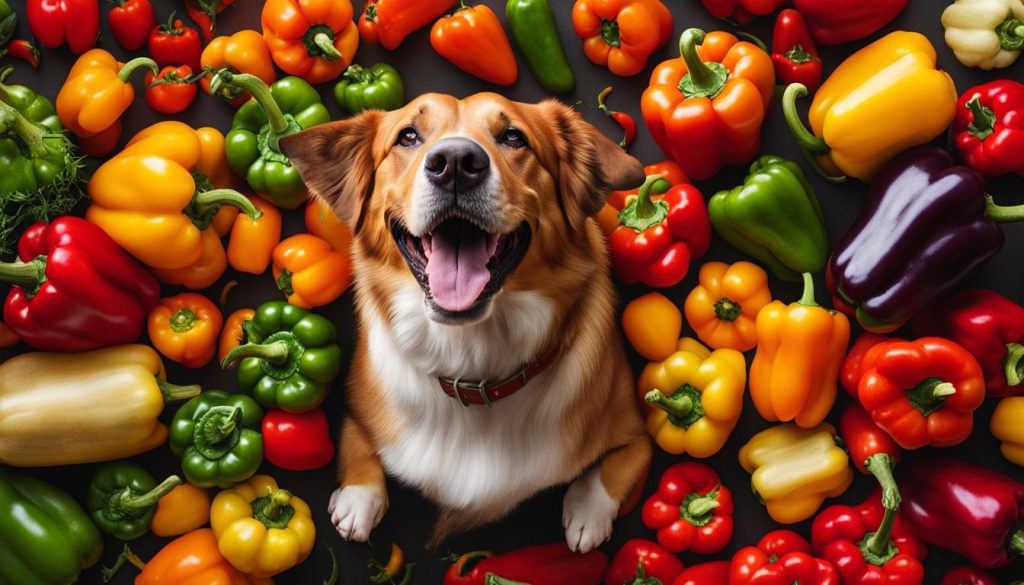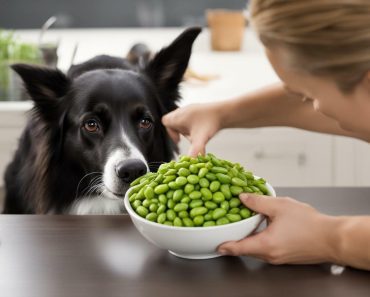When it comes to feeding our furry friends, it’s important to understand which human foods are safe and beneficial for them. One popular question that often arises is whether dogs can eat bell peppers. Well, the good news is that bell peppers are indeed safe for dogs to consume, and they can even provide several health benefits!
Bell peppers are packed with essential vitamins and antioxidants, such as vitamins A, E, B6, C, and beta-carotene, which are all beneficial for supporting a dog’s immune system, skin, coat, and eye health. Whether it’s the vibrant red or other color varieties, bell peppers can be a nutritious addition to a dog’s diet.
However, it’s crucial to introduce bell peppers slowly and in moderation to avoid any potential stomach upset. It’s also important to remember that bell peppers should be prepared safely for dogs. Always remove the seeds, stems, and never add any seasoning, salt, onions, garlic, or spicy varieties.
If you are considering adding bell peppers to your dog’s diet, it’s always a good idea to consult with your veterinarian first. They can provide personalized advice based on your dog’s specific needs and dietary requirements.
Are Bell Peppers Good for Dogs?
Bell peppers are not only a delicious and colorful addition to our meals, but they can also be a healthy snack for our furry friends. These crunchy vegetables are packed with essential vitamins and antioxidants that can benefit a dog’s overall well-being.
Bell peppers are particularly rich in vitamins A, C, E, and B6, as well as beta-carotene. These nutrients play a vital role in supporting a dog’s immune system, promoting healthy skin and coat, and maintaining good eye health. In addition to vitamins, bell peppers are also a good source of fiber, aiding in digestion and promoting a healthy weight.
When feeding bell peppers to your dog, it’s important to remember a few key points. Firstly, always remove the seeds and stems, as they can pose a choking hazard. Secondly, make sure to serve bell peppers in moderation, as too much of any new food can cause digestive upset. Lastly, avoid adding any seasonings or spices, as some can be harmful to dogs. By following these guidelines, you can safely introduce bell peppers as a nutritious and delicious treat for your furry companion.
Healthy Snacks for Dogs
While bell peppers are a great option, there are other healthy snacks that you can offer your dog. Carrots make an excellent low-calorie and crunchy treat, packed with vitamins and fiber. Blueberries are another fantastic choice, as they are rich in antioxidants and can help support a dog’s cognitive function. Green beans are also a popular option, providing a good source of vitamins and minerals while being low in calories. These snacks can be given in moderation as part of a balanced diet and should always be introduced slowly to ensure your dog’s digestive system adjusts well.
Remember, when introducing any new food to your dog’s diet, it’s essential to consult with your veterinarian. They can provide guidance on portion sizes, potential allergies or sensitivities, and ensure your dog’s overall nutritional needs are being met. With proper care and moderation, bell peppers and other healthy snacks can be a tasty and beneficial addition to your dog’s diet.
How Much Bell Pepper Can Dogs Eat?
When it comes to feeding bell peppers to dogs, it’s important to consider the appropriate portion size. The amount of bell pepper your dog can eat will depend on their size. For small dogs, it is recommended to start with one or two small pieces of bell pepper. Larger dogs can safely consume up to half a small pepper.
It’s crucial to introduce bell peppers slowly and in moderation to prevent stomach upset. Begin with a small amount and monitor your dog’s reaction. If they experience any digestive issues such as vomiting or diarrhea, reduce or discontinue the amount of bell pepper given. Remember, bell peppers should only make up a small portion of a dog’s overall diet, with the majority of their nutrition coming from balanced dog food.
Consulting with your veterinarian before adding bell peppers to your dog’s diet is also highly recommended. They can provide specific guidelines based on your dog’s individual needs and ensure that bell peppers are a suitable addition to their diet.
How to Safely Prepare Bell Peppers for Dogs
When it comes to serving bell peppers to your furry friend, proper preparation is essential to ensure their safety and enjoyment. Here are some guidelines for safely preparing bell peppers for dogs:
1. Removing Seeds and Stems
Prior to feeding bell peppers to your dog, make sure to remove the seeds and stems. These parts can pose a choking hazard, especially for smaller dogs. By taking a few extra seconds to remove them, you can prevent any potential accidents and keep your dog safe.
2. Seasoning and Salt-Free
It’s important to serve bell peppers to dogs in their natural state, without any added seasonings or salt. While we may enjoy our bell peppers with a dash of seasoning, it’s best to keep it plain and simple for our four-legged friends. Seasonings and salt can be harmful to dogs and may cause digestive issues or other health problems.
3. Raw or Lightly Steamed
You have the option to serve bell peppers to your dog raw or lightly steamed. Raw bell peppers offer a refreshing crunch and can be a fun snack for your pup. However, if your dog has difficulty chewing or prefers a softer texture, lightly steaming the bell peppers can make them easier to consume.
Overall, safely preparing bell peppers for dogs involves removing seeds and stems, avoiding seasonings and salt, and choosing between serving them raw or lightly steamed. By following these guidelines, you can ensure that your furry friend can enjoy the nutritional benefits and delicious taste of bell peppers in a safe and enjoyable way.
The Benefits of Bell Peppers for Dogs
Bell peppers offer several health benefits for dogs. They are rich in vitamins A, C, E, and B6, which support a dog’s immune system, eye health, skin, coat, and nervous system. These vitamins play a crucial role in maintaining overall well-being in dogs. Bell peppers are also a good source of antioxidants, including beta-carotene and lycopene. These antioxidants help fight off damaging free radicals, reduce inflammation, and protect against certain diseases.
In addition to vitamins and antioxidants, bell peppers are high in fiber. Fiber is essential for a healthy digestive system and can help regulate bowel movements in dogs. It aids in maintaining a healthy weight and can reduce the risk of obesity. Furthermore, bell peppers have hydrating properties, contributing to a dog’s overall hydration levels.
When incorporating bell peppers into a dog’s diet, it’s important to remember that they should be given in moderation. While they offer many health benefits, they should not make up a large portion of a dog’s daily food intake. Bell peppers should be served plain, without any added seasonings or spices. It’s always best to consult with a veterinarian before introducing new foods to your dog’s diet to ensure they are suitable for your pet’s specific needs.

The Risks of Feeding Bell Peppers to Dogs
Bell peppers are generally safe for dogs to consume, but there are a few risks to be aware of when feeding them to your furry friend. One potential risk is the possibility of digestive issues. Dogs who consume too much bell pepper at once may experience stomach upset, such as diarrhea or vomiting. To avoid this, it’s important to introduce bell peppers slowly and in small amounts, monitoring your dog’s reaction closely.
Another risk is the potential choking hazard that bell peppers can pose, especially for smaller dogs. The large pieces or stems of bell peppers may be difficult for them to swallow, leading to choking. To prevent this, always cut the bell peppers into appropriate bite-sized pieces and remove the stems before feeding them to your dog.
It’s also important to note that not all peppers are safe for dogs. Peppers such as jalapenos or chili peppers contain capsaicin, which can cause digestive upset and discomfort in dogs. These types of peppers should be avoided when considering bell peppers as a treat for your pet.
The Risks of Feeding Bell Peppers to Dogs: Summary
While bell peppers can provide some health benefits to dogs, it’s crucial to be aware of the potential risks associated with feeding them. These risks include digestive issues from consuming too much bell pepper, the choking hazard of large pieces or stems, and the toxic nature of certain peppers like jalapenos or chili peppers. By introducing bell peppers in moderation, cutting them into appropriate sizes, and avoiding toxic peppers, you can safely incorporate this vegetable into your dog’s diet.
Feeding Bell Peppers to Your Dog: Creative Ways to Serve
Bell peppers can be a versatile and nutritious addition to your dog’s diet. Here are some creative ways to serve bell peppers to your furry friend:
Making Dog-Friendly Bell Pepper Treats
You can easily turn bell peppers into delicious frozen treats for your dog. Slice the bell peppers into small, bite-sized pieces and place them on a baking sheet. Pop the sheet into the freezer and let the bell pepper pieces freeze completely. Once frozen, these treats can provide a refreshing and crunchy snack for your dog, especially during hot summer days.
Stuffing Bell Peppers with Dog-Safe Fillings
Another way to incorporate bell peppers into your dog’s meals is by stuffing them with dog-friendly fillings. For example, you can mix cooked ground turkey or chicken with cooked quinoa or rice and some finely chopped vegetables. Stuff the mixture into halved bell peppers and bake them until the peppers are tender. This can be a nutritious and flavorful meal option for your pup.
Adding Bell Peppers to Homemade Dog Food
If you like to prepare homemade meals for your dog, you can add bell peppers as a nutritious ingredient. Chop the bell peppers into small pieces and sauté them lightly before mixing them with other cooked ingredients like lean meats and vegetables. This can add texture, flavor, and essential vitamins to your dog’s homemade meals.
Remember to always remove the seeds, stems, and seasonings from the bell peppers before serving them to your dog. Additionally, it’s important to introduce new foods gradually and monitor your dog’s reaction. If you notice any signs of digestive upset or allergies, consult your veterinarian.

Other Dog-Friendly Vegetables
When it comes to incorporating vegetables into your dog’s diet, there are plenty of safe and nutritious options to choose from. Not only can vegetables provide additional vitamins and minerals, but they can also add variety and flavor to your furry friend’s meals. Here are some dog-friendly vegetables to consider:
Broccoli: Rich in fiber and vitamin C, broccoli can be a healthy addition to your dog’s diet. Steam or lightly cook it for easier digestion.
Carrots: Carrots are packed with beta-carotene, which supports eye health. They also make a crunchy and satisfying snack for dogs of all sizes.
Sweet Potatoes: Sweet potatoes are a great source of dietary fiber, vitamin A, and antioxidants. They can be cooked and mashed or thinly sliced and baked into tasty treats.
Spinach: Spinach is a leafy green vegetable that is rich in iron and other vitamins. It can be served cooked or raw, but remember to chop it into smaller pieces for easier consumption.
Cucumbers: Cucumbers are hydrating and low in calories, making them a refreshing snack for dogs on hot days. Just be sure to remove the seeds before offering them to your pup.
When incorporating vegetables into your dog’s diet, it’s important to introduce them gradually and in moderation. Keep in mind that every dog is different, and some may have specific dietary restrictions or sensitivities. If you have any concerns or questions, consult with your veterinarian before making any changes to your dog’s meal plan. By adding a variety of dog-friendly vegetables to their diet, you can help promote their overall health and well-being.
FAQ
Can dogs eat bell peppers?
Yes, bell peppers are safe for dogs to eat.
Are bell peppers good for dogs?
Yes, bell peppers provide numerous health benefits for dogs.
How much bell pepper can dogs eat?
The amount of bell pepper dogs can eat depends on their size.
How to safely prepare bell peppers for dogs?
Remove the seeds and stems and avoid adding any seasoning or salt.
What are the benefits of bell peppers for dogs?
Bell peppers are packed with vitamins, minerals, and antioxidants that can be beneficial to a dog’s health.
What are the risks of feeding bell peppers to dogs?
Eating too much bell pepper at once can cause digestive upset, and large pieces or stems can pose a choking hazard.
How can I serve bell peppers to my dog?
Bell peppers can be served raw, lightly steamed, or used in various dog-friendly recipes.
Are there other vegetables that are safe for dogs?
Yes, there are several other dog-friendly vegetables that can be incorporated into a dog’s diet.






